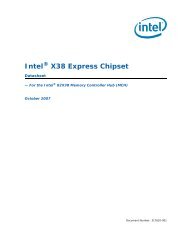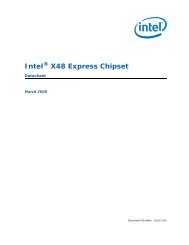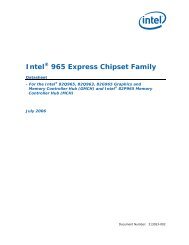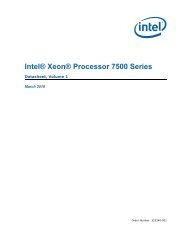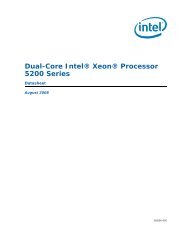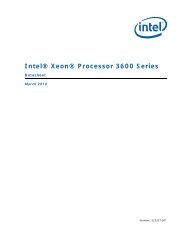Intel® 945G/945GZ/945GC/ 945P/945PL Express Chipset Family ...
Intel® 945G/945GZ/945GC/ 945P/945PL Express Chipset Family ...
Intel® 945G/945GZ/945GC/ 945P/945PL Express Chipset Family ...
You also want an ePaper? Increase the reach of your titles
YUMPU automatically turns print PDFs into web optimized ePapers that Google loves.
10.5 Integrated Graphics Device (Intel ®<br />
82<strong>945G</strong>/82<strong>945G</strong>C/82<strong>945G</strong>Z GMCH Only)<br />
Functional Description<br />
The major components in the Integrated Graphics Device (IGD) are the engines, planes, pipes and<br />
ports. The GMCH has a 3D/2D instruction processing unit to control the 3D and 2D engines. The<br />
IGD’s 3D and 2D engines are fed with data through the memory controller. The output of the<br />
engines are surfaces sent to memory that are then retrieved and processed by the GMCH planes.<br />
The GMCH contains a variety of planes, such as display, overlay, cursor and VGA. A plane<br />
consists of rectangular shaped image that has characteristics such as source, size, position,<br />
method, and format. These planes get attached to source surfaces that are rectangular memory<br />
surfaces with a similar set of characteristics. They are also associated with a particular destination<br />
pipe.<br />
A pipe consists of a set of combined planes and a timing generator. The GMCH has two<br />
independent display pipes, allowing for support of two independent display streams. A port is the<br />
destination for the result of the pipe. The GMCH contains three display ports; 1 analog (DAC)<br />
and two digital (SDVO ports B and C). The ports will be explained in more detail later in this<br />
section .<br />
The entire IGD is fed with data from its memory controller. The GMCH’s graphics performance<br />
is directly related to the amount of bandwidth available. If the engines are not receiving data fast<br />
enough from the memory controller (e.g., single-channel DDR2 533), the rest of the IGD will also<br />
be affected.<br />
The rest of this section will focus on explaining the IGD components, their limitations, and<br />
dependencies.<br />
10.5.1 3D Graphics Pipeline<br />
The GMCH graphics is the next step in the evolution of integrated graphics. In addition to<br />
running the graphics engine at 400 MHz, the GMCH graphics has four pixel pipelines that<br />
provide a 1.3 GB/s fill rate that enables an excellent consumer gaming experience.<br />
The 3D graphics pipeline for the GMCH has a deep pipelined architecture in which each stage<br />
can simultaneously operate on different primitives or on different portions of the same primitive.<br />
The 3D graphics pipeline is divided into four major stages: geometry processing, setup (vertex<br />
processing), texture application, and rasterization.<br />
The GMCH graphics is optimized for use with current and future Intel ® processors for advance<br />
software based transform and lighting techniques (geometry processing) as defined by the<br />
Microsoft Direct X* API. The other three stages of 3D processing are handled on the integrated<br />
graphics device. The setup stage is responsible for vertex processing; converting vertices to<br />
pixels. The texture application stage applies textures to pixels. The rasterization engine takes<br />
textured pixels and applies lighting and other environmental affects to produce the final pixel<br />
value. From the rasterization stage, the final pixel value is written to the frame buffer in memory<br />
so it can be displayed.<br />
239



